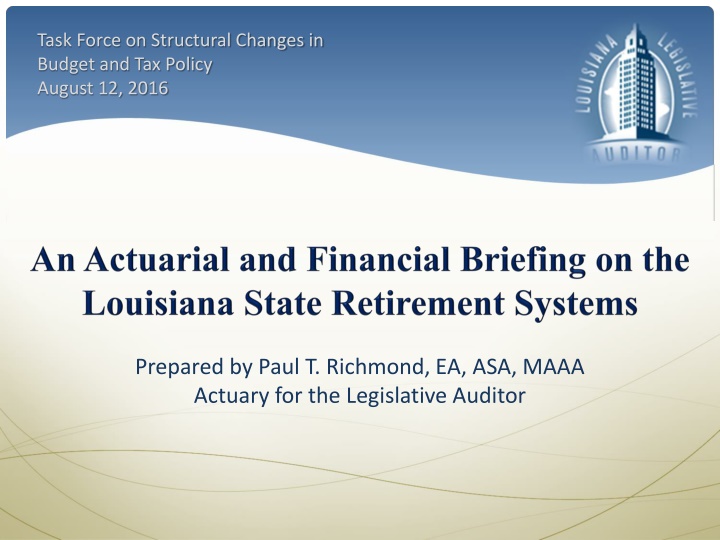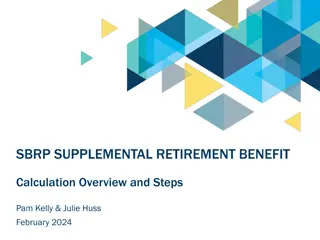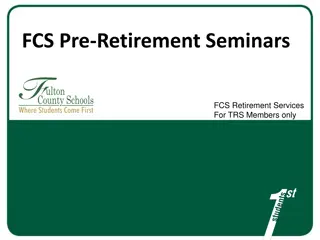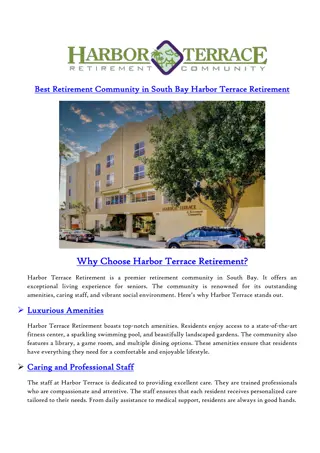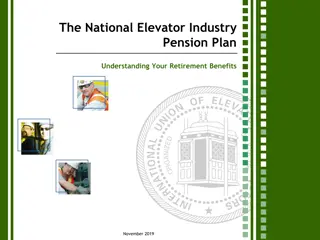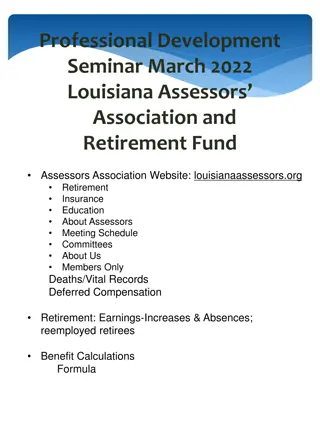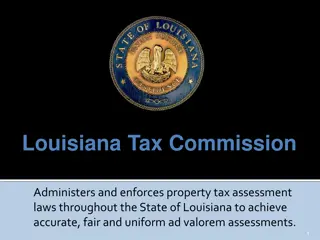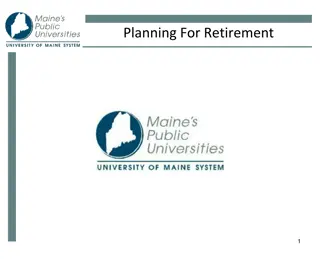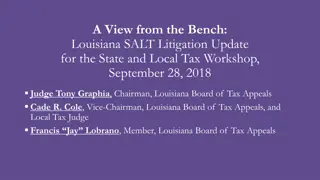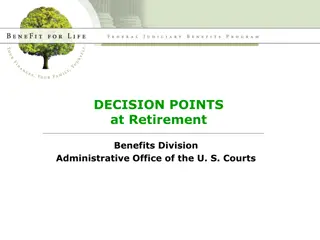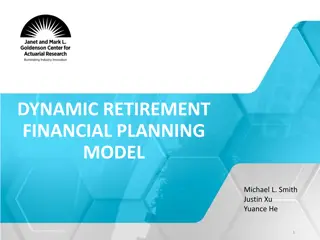Analysis of Louisiana State Retirement Systems Sustainability
The report by Paul T. Richmond, EA, ASA, MAAA, Actuary for the Legislative Auditor, highlights the sustainable nature of Louisiana state retirement systems despite accumulated debts. It emphasizes the need for contributions to address the Unfunded Accrued Liabilities (UAL) and discusses strategies to maintain financial stability. Recommendations include transparency in cost valuation, symmetrical amortization of gains and losses, reassessment of discount rates, and creating reserves for contribution stability. Overall, the retirement systems are deemed to be in a relatively good financial position with sustainable payment structures.
Download Presentation

Please find below an Image/Link to download the presentation.
The content on the website is provided AS IS for your information and personal use only. It may not be sold, licensed, or shared on other websites without obtaining consent from the author.If you encounter any issues during the download, it is possible that the publisher has removed the file from their server.
You are allowed to download the files provided on this website for personal or commercial use, subject to the condition that they are used lawfully. All files are the property of their respective owners.
The content on the website is provided AS IS for your information and personal use only. It may not be sold, licensed, or shared on other websites without obtaining consent from the author.
E N D
Presentation Transcript
Task Force on Structural Changes in Budget and Tax Policy August 12, 2016 Prepared by Paul T. Richmond, EA, ASA, MAAA Actuary for the Legislative Auditor
August 13, 2015 The Louisiana state retirement systems are sustainable
1. The problem with the retirement systems is not the plan design, but rather it is the fact that UALs (debts) have accumulated in the past that now must be paid. 2. The retirement systems cannot invest their way out of the UAL hole; contributions toward the UAL are necessary. 3. In general, however, the risk analysis presented in the August 13, 2015 Sustainability Report shows LASERS and TRSL to be in a relatively good financial position. 4. The current defined benefit structure applicable to future benefit accruals for existing and new active members is definitely sustainable.
5. Payments toward the UAL are generally sustainable. 6. There is a risk that employer contribution requirements toward the UAL in any given year over the next decade may be larger than current levels because of market volatility. This could stress participating employers from time to time. 7. Assumptions and methods must be monitored continuously to avoid a pattern of increasing UALS from occurring in the future. 8. Because assumptions and methods must be unbiased, a reserve for adverse experience can be developed only by contributing more that the actuarially calculated amount. 9. It is better to have larger contributions initially with a gradual decline thereafter than to have smaller contributions initially with a pattern of rising contributions.
1. Consider a level annual COLA that is equivalent in cost to the current complex unpredictable gain sharing/COLA program. 2. Value the cost of the current gain sharing/COLA program explicitly rather than implicitly. This will provide more transparency in the cost of the program. 3. Require symmetrical amortization of gains and losses with level payments over period not to exceed 20 years. 4. Provide for direct recognition of administrative expense through an adjustment to the normal cost. 5. Reassessment of the discount rate. 6. Use a Funding Deposit Account to create reserves for contribution stability.
1. The sources of the UAL. 2. The gain sharing / COLA program 3. The effect of an additional $100 million annual contribution 4. Alternative uses for additional contributions
Accrued Liability $ 46.863 Assets 28.776 UAL $ 18.087 OAB Initial UAL $ 4.108 EAAB UAL Incurred from 1987 - 2009 6.243 Recent UAL UAL Incurred from 2010 - 2015 7.736 Total UAL $ 18.087
A.Initial UAL at FYE 1989 $ 5.834 B.Additions to UAL including: 1.Delayed Amortization Leading to UAL Growth 2.Net Investment Losses 3.Losses Due to Actuarial Experience $ 2.816 3.090 3.111 4.Benefit Increases Excluding COLAs 5.Subtotal = (1) + (2) + (3) + (4) 0.009 9.026 C.Present Value Cost of COLAs 2.968 D.Experience Account (EA) Transactions 1.Allocatons to to the EA 3.146 2.Receipts from the EA 2.886 3.Net Loss of Assets = (D1) - (D2) 0.260 E.UAL at FYE 2015 = A + B + C + D $ 18.088
Hurdles 1. Allocations of investment gains for LASERS depend upon the extent to which gains exceed Hurdle 1 ($50 million) or Hurdle 2 ($100 million). 2. The following rules apply based on investment gains relative to the two hurdle amounts: a. The first $50 million of investment gains are allocated to the OAB b. Investment gains from $50 million to $100 million are allocated to the EAAB. c. Investment gains that exceed $100 million are potentially allocated to the Experience Account. 3. The $50 million and $100 million hurdles are indexed each year according to ratio of assets at the end and the beginning of the year. Hurdle amount can increase; they cannot decrease 4. All losses are allocated to the retirement system. 5. The thresholds for TRSL are $100 and $200 million respectively.
Transfer Limitations The maximum investment gain that may be transferred to the Experience Account for a given year depends on the funded ratio and the following chart: Funded Ratio on Valuation Date Transfer Amount May Not Exceed Less than 55% No transfer is allowed. The difference between the cost of a full 1.5% COLA and the amount already in the Experience Account. 55% to 65% The difference between the cost of a full 2.0% COLA and the amount already in the Experience Account. 65% to 75% The difference between the cost of a full 2.5% COLA and the amount already in the Experience Account. 75% to 80% The difference between the cost of a full 3.0% COLA and the amount already in the Experience Account. 80% or More
COLA Limitations The maximum COLA that may be granted for a given year depends on the funded ratio, whether a grant had been made in the prior year, and whether there are sufficient assets in the Experience Account to fund the COLA. Conditions Necessary for a Tentative COLA Tentative COLA Grant = the Lesser of the CPI-U and Funded Ratio PBI Granted in Prior Year? Less than 55% n/a 0.0% 55% 65% No 1.5% 65% 75% No 2.0% 75% 80% No 2.5% 80% or More n/a 3.0%
Other COLA Rules 1. If the rate of return on the actuarial value of assets for a fiscal year is less than 8.25%, the a COLA may be granted. However, the maximum COLA will be the lesser of: a. 2.0%, b. The increase in the CPI-U 2. No COLA may be granted if the actuarial return on assets is less than the assumed rate of return and the funded ratio of the system is less than 80%. 3. No COLA may be granted if the balance in the Experience Account is less than the actuarial present value of a full COLA.
The Cost of Gain Sharing/COLA Program LASERS TRSL Average Frequency of Transfers to the Experience Account 40% 41% Average Amount of Transfer to the Experience Account $63.7 million $125.0 million Equivalent Annual COLA 0.75% 0.76%
1. Strengthen actuarial assumptions. 2. Reduce employer contribution requirements. 3. Reduce the IUAL and IUAL employer contribution requirements. 4. Reduce New UALs and New UAL employer contribution requirements. 5. Eliminate the Experience Account and fund an annual COLA. 6. Establish a funding reserve account. 7. Actuarial/Legal Cleanup
Strengthen Actuarial Assumptions Concept: The state contributes $100 million more each year and the retirement systems reduce the discount rate by 50 basis points. Result: Employer contribution rate for LASERS will increase 4.0% from 35.8% to 39.8%. Employer contribution rate for TRSL will be reduced 3.6% from 25.4% to 29.0%. Total employer contribution requirements increases $238 million a year.
Reduce Employer Contribution Requirements Concept: The state contributes $100 million more each year than the actuarially calculated contribution requirement. Result: Employer contribution rate for LASERS will be reduced 1.6% from 35.8% to 34.2%. Employer contribution rate for TRSL will be reduced 1.6% from 25.4% to 23.8%.
Apply to IUAL Concept: The state contributes $100 million more each year toward the IUAL than that required by the current amortization schedule.
Apply to the IUAL Effect of an Extra $100 Million Contribution On IUAL Payments Effect of an Extra $100 Million Contribution On IUAL Balance 1,000 5,000 800 4,000 Millions of Dollars Millions of Dollars 600 3,000 400 2,000 200 1,000 0 0 2016 2020 2024 2028 2016 2020 2024 2028 With $100 Million Without $100 Million With $100 Million Without $100 Million
Eliminate Experience Account and Establish Annual COLA Concept: The state contributes $100 million more each year and changes the law to provide a 0.75% COLA every year. Result: 1. Increase in annual employer contribution requirements is about 120 million. 2. Increase in the employer contribution rate is about 1.9% of pay.
Establish a Funding Reserve Account Concept: The state contributes $100 million more each year. The additional contributions are placed into a side fund to be used to reduce contribution volatility. Analysis: 1. For the two year period from July 1, 2008 to June 30, 2010, actuarial losses for the retirement systems exceeded $6.0 billion. 2. An annual deposit of $100 million in a side fund will accumulate to $1.5 billion after ten years.
Actuarial/Legal Cleanup Concept: The state contributes $100 million more each year. The places in the law that conflict with actuarial standards of practice are amended. Result: 1. The law will be compatible with the Louisiana constitution that provides: actuarial soundness shall be attained and maintained . 2. Administrative expenses pertaining to actuarial fess will be reduced.
Conclusions 1. The are many uses for an extra $100 million annual contribution. 2. However, $100 million is not sufficient to do anything meaningful for retirees or for actuarial soundness. 3. Although none of the retirement systems would reject its share of the $100 million amount, an annual contribution of at least $500 million would be necessary to have any significant effect on the systems financial and actuarial security.
